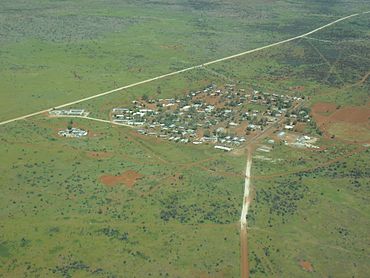Amaṯa, South Australia facts for kids
Quick facts for kids AmaṯaSouth Australia |
|||||||||
|---|---|---|---|---|---|---|---|---|---|
 |
|||||||||
| Population | 319 (2006) | ||||||||
| Established | 1961 | ||||||||
| Postcode(s) | 5710 | ||||||||
| Elevation | 690 m (2,264 ft) | ||||||||
| Location | 1,407 km (874 mi) north-west of Adelaide via |
||||||||
| LGA(s) | Aṉangu Pitjantjatjara Yankunytjatjara | ||||||||
| State electorate(s) | Giles | ||||||||
| Federal Division(s) | Grey | ||||||||
|
|||||||||
Amaṯa is an Aboriginal community in the Aṉangu Pitjantjatjara Yankunytjatjara Lands in South Australia. It is in the north of the APY, between Umuwa and Nyapari. It is at the base of the Musgrave Ranges, about 250 kilometres (160 mi) west of the Stuart Highway. Amaṯa was established under the name of Musgrave Park in 1961. The community was set up to take the pressure off the growth of nearby Pukatja (then known as Ernabella). The goal was to use it to teach the Aborigines in how to work in the livestock industry. A school was opened 7 years later, in 1968.
About 319 people lived at Amaṯa in the 2006 census. It appears to have a growing population, which is not the usual pattern for Aboriginal communities in Australia. From 180 residents in 1981, it has grown steadily past 350 in the 1990s, to 536 in 1996.
Amaṯa is made up of about 60 houses. There is a school, a general store and a health clinic. Supplies are delivered once per week and mail is delivered twice per week. Water comes from bores and is stored in tanks. The school was renovated by the state government from 2003–2005. A swimming pool was opened in June 2007. Amaṯa also has a community centre, a community church, and an airstrip.
There is a police station at Amaṯa, but they are not always there; state police are based in Marla and run patrols to the area. Some night patrols by residents have been done in the past to help policing of the community. In the absence of police, the community is served by 2 community constables. Tony Abbott suggested in 2007 there should be police at Amaṯa permanently. In response, the state government said it would spend A$7.5 million at Amaṯa and Pukatja for new police stations, court facilities and prison cells. It would also provide housing for police officers.
The sale of local artwork is important to the economy of the Amaṯa community. Tjala Arts, founded in 1999, displayed the works of seven Amaṯa artists in Canberra in 2006. In the 2007 State Budget, the South Australian Government announced $350,000 for a new arts centre in Amaṯa.


